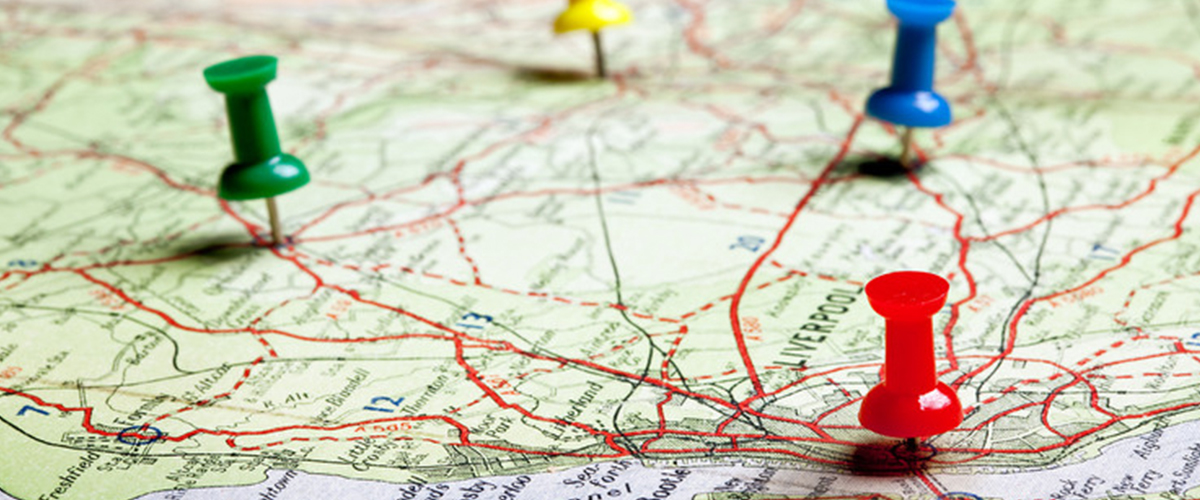
What’s your roadmap for 2019?
01.25.19
Nerd alert.
I was a map geek as a kid.
Any time I was in the car – whether a long family vacation or a short day trip to Toronto – it was in the back seat with a map and a green highlighter to plot our route. It helped me pass the time (I hated car travel), but mostly I was interested in maps. Mom and Dad tolerated me. My siblings rolled their eyes.
Fast forward 45 years… I’m still the same. I’ll open Google Maps multiple times a day to find a location I’m reading about or one I see referenced in the news. I’m also the guy sitting beside you on the plane who’s more interested in the flight map than watching the movie, even if we’re five hours in the air.
It’s an affliction.
This played out again on a trip west a few weeks ago. My friend, Mike, sat beside me and worked most of the time. I had one eye in a file… and both eyes on the screen with the flight route in front of me. I knew our altitude, wind speed, and especially what we were flying over: Lake Michigan, Chicago, a lot of nothingness on the plains, and then Denver, the Rockies, the Grand Canyon, Vegas strip, and finally Los Angeles.
I guess I’ve always been fascinated with maps.
It’s why today a different map plays an important role in my business– and probably yours too. We typically call them plans, but I see them for what they really are: roadmaps. We use them for big things and small, for ourselves and our families, our vacations and homes, in business and in life. Anything, really.
So, here we are in January – still early enough in 2019 to ensure we have our roadmaps in place for whatever holds our attention (and effort) this year.
But what exactly makes a good roadmap?
What are its parts?
And how do we use them to our advantage?
My trip with Mike offers a simple example – particularly in cleaning up confusion I often see with terms like “vision,” “strategy” and “action plans.”
What’s what exactly?
The where, the how & the what
For me, a good roadmap answers three basic questions:
1. Where are you going?
This is your vision or aspiration. We can’t truly start without knowing where we’re headed. It might be a goal for a three-month project, a hope for 2019, a five-year vision, or even a dream that’s 10 years out. It’s your destination, as specific and vivid as you can imagine it. For me and Mike, the destination was Los Angeles, but we were really after something more specific: new thinking, broadening our horizons, and unlocking possibilities for collaboration. That was the real vision for our trip; L.A. was just the locale.
2. How will you get there?
This is strategy. It’s the broad brushes (or building blocks) for how you’ll reach your destination. Most visions have a strategy with perhaps three or four core “planks,” not many more, and maybe only one or two. Our strategy for three days was a simple hybrid of “on and off” time. The on-time included a brand ‘research’ visit to an innovative financial company in Santa Monica, along with some scheduled time for new thinking. The off-time included a couple of leisurely dinners, some creative conversations, and even a fast visit to the Santa Monica Pier. Nothing complicated, but a strategy all the same.
3. What will you specifically do to make it happen?
These are tactics, or actions. If strategy is 20,000 feet up, tactics are down at ground level. They’re the specific actions that make a strategy come to life – all in pursuit of our destination. For our trip, tactics included everything from booking flights and hotels, choosing restaurants, arranging and attending our meetings, being exposed to new learning, and doing some prep thinking in advance. Any strategy will have multiple tactics, perhaps dozens. We were no different. (Tactics are also granular enough to have accountabilities attached: i.e. who will do what… by when?)
To recap:
- Vision: New ideas, fresh thinking.
- Strategy: ‘On-and-off’ time that balanced structured time with creativity.
- Tactics: Flights, hotels, meetings, agendas, dinners, Ubers, prep time, yada yada yada.
I think we’d all agree we need a decent roadmap to get to our destination. We probably don’t get there without one.
Hope is not a strategy.
The practicality of all of this? Our where + how + what thinking applies to any level of planning, from small projects to big dreams… and anything in between.
So, ask yourself:
- Are you clear on where you’re going in 2019?
- Do you know how you’ll get there?
- What will you specifically do to make it happen?
